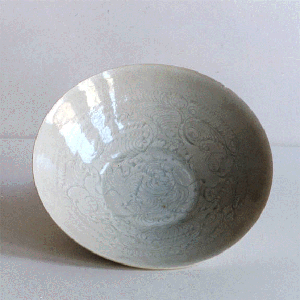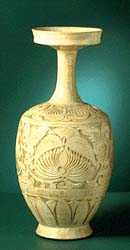The Northern and
Southern Song dynasties
 Chao K’uang-yin founded the Song dynasty. He was a general, made
emperor by his soldiers in 960 A.D. Unlike the generals before him who had
declared themselves emperors of dynasties that soon failed, Chao K’uang-yin
lived a long life. This allowed him to establish a more solid foundation for his
successors. Another reason that his dynasty lasted longer was that he did not
try to fight the Khitans to the north; rather he conquered the southern half of
China. The southern kingdoms, while economically and culturally advanced, did
not have strong militaries and were relatively easy to defeat. In order to
maintain peace with the Khitans, the Song were forced to pay them annual
tributes. These annual tributes were more cost effective than maintaining a
military that could hold the Khitans back.
Chao K’uang-yin founded the Song dynasty. He was a general, made
emperor by his soldiers in 960 A.D. Unlike the generals before him who had
declared themselves emperors of dynasties that soon failed, Chao K’uang-yin
lived a long life. This allowed him to establish a more solid foundation for his
successors. Another reason that his dynasty lasted longer was that he did not
try to fight the Khitans to the north; rather he conquered the southern half of
China. The southern kingdoms, while economically and culturally advanced, did
not have strong militaries and were relatively easy to defeat. In order to
maintain peace with the Khitans, the Song were forced to pay them annual
tributes. These annual tributes were more cost effective than maintaining a
military that could hold the Khitans back.
Great advances were made in the areas of technological invention, material
production, political philosophy, government, and elite culture. The Song used
gunpowder as a weapon in siege warfare, foreign trade expanded greatly, and the
Chinese had the best ships in the world. Their ships contained as many as four
decks, six masts, and a dozen sails. The ships were guided by a stern post
rudder, while navigation was done through the use of charts and compasses. These
ships could carry 500 men. European ships on the other hand used muscle power
and an inefficient steering oar. Advances were also made in medicine, as the
first autopsy was performed in about 1145 AD on the body of a Southern Chinese
captive.
Education, and the examination system became central to the upper class. This
rise in the popularity of education was due in part to advances made in printing
and the greater availability of books. Examinations grew steadily in popularity
throughout China; although, only enough were allowed to pass them as was needed
to fill the administrative positions. This resulted in the education itself, and
the attempted examination, gaining more importance socially than it had in the
past.
Neo-Confucianism was developed during this time, especially during the
Southern Song dynasty. Zhu Xi was one of the people who helped develop
Neo-Confucianism. While not the only person to write about Confucianism, he was
the one who combined others works with his and best organized the beliefs. He
selected, from the ancient writings on Confucianism, the Four Books and
also synthesized the writings of previous philosophers who had been active
earlier during the Northern Song era. An important part of Neo-Confucianism is
the attempt to "repossess the Way." Pursuit of the Way through disciplined self
cultivation formed a person's character. This was important because it
encouraged the nobles to live up to the Confucian ideals by being less
selfish.
 |
| Image courtesy of
ART123.com |
While poetry and painting gained importance, some poets began using the
vernacular in their writings. In the past it had been very unusual to use
phrases from everyday life. Painting reached new heights during this time. There
were two main schools of painters. The first created decorative, yet realistic,
paintings that show a great attention to detail. The second tried to paint inner
realities, as they viewed painting to be an intimate personal expression. Near
the end of the Song dynasty, the famous blue and white porcelain was created.
The most common porcelain was the type known as Celadon.
While being one of the most technologically and culturally advanced people in
the world at the time, the Song were not militarily powerful. Part of the reason
for this may be because Confucianism held military in very low regard.
Confucianism did not recognize the military as being part of the four official
classes of occupations; therefore, the military consisted of either the poor,
uneducated peasants, mercenaries or allies. Diplomacy was the favored form of
dealing with enemies. This prolonged period of paying tribute to enemies, rather
than being militarily strong enough to defeat them, left the Song susceptible to
attack from others. This weakness allowed for two non-Chinese kingdoms to exist
to the north of the Song. They were the Liao and the Western Xia. All three of
these kingdoms favored diplomacy over military aggression. Thus by 1125 A.D., a
group called the Jin were able to conquer the Liao and the Song, along with part
of the territory of the Western Xia. A brother of the Song emperor fled south,
and declared himself emperor. His dynasty is generally known as the Southern
Song.
The Southern Song experienced a temporary return to peace, and culturally
they too flourished. However, the power was mainly held by the nobles, and many
emperors were forced, by the nobles, to abdicate. This period did not last long,
as in 1210 A.D. the Mongols began to assault the Song, and in 1279, the Yuan, or Mongol empire began.
 Chao K’uang-yin founded the Song dynasty. He was a general, made
emperor by his soldiers in 960 A.D. Unlike the generals before him who had
declared themselves emperors of dynasties that soon failed, Chao K’uang-yin
lived a long life. This allowed him to establish a more solid foundation for his
successors. Another reason that his dynasty lasted longer was that he did not
try to fight the Khitans to the north; rather he conquered the southern half of
China. The southern kingdoms, while economically and culturally advanced, did
not have strong militaries and were relatively easy to defeat. In order to
maintain peace with the Khitans, the Song were forced to pay them annual
tributes. These annual tributes were more cost effective than maintaining a
military that could hold the Khitans back.
Chao K’uang-yin founded the Song dynasty. He was a general, made
emperor by his soldiers in 960 A.D. Unlike the generals before him who had
declared themselves emperors of dynasties that soon failed, Chao K’uang-yin
lived a long life. This allowed him to establish a more solid foundation for his
successors. Another reason that his dynasty lasted longer was that he did not
try to fight the Khitans to the north; rather he conquered the southern half of
China. The southern kingdoms, while economically and culturally advanced, did
not have strong militaries and were relatively easy to defeat. In order to
maintain peace with the Khitans, the Song were forced to pay them annual
tributes. These annual tributes were more cost effective than maintaining a
military that could hold the Khitans back.
